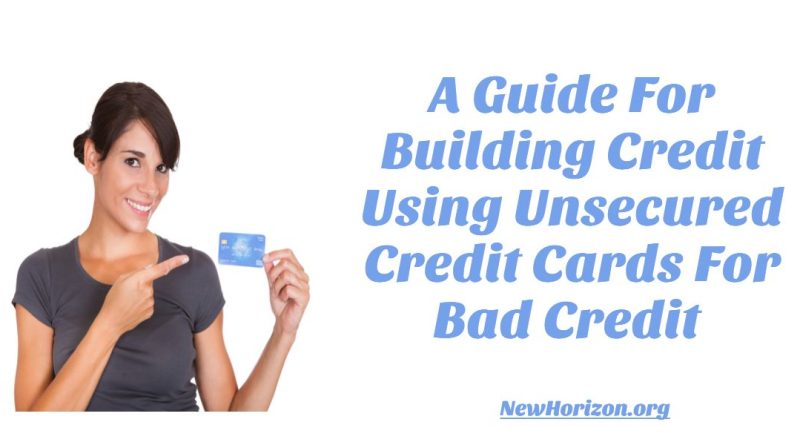Building Credit with Unsecured Credit Cards For Bad Credit: A Step-by-Step Guide
Building credit is essential for achieving financial stability and gaining access to better loan terms and credit opportunities. For individuals with bad credit, unsecured credit cards designed specifically for their needs can serve as a valuable tool to rebuild their creditworthiness. In this step-by-step guide, we will explore how to effectively use unsecured credit cards for bad credit to build a positive credit history.
Step 1: Understand the Basics of building credit
Before diving into the process, it’s important to familiarize yourself with some key concepts related to credit and what unsecured credit cards for bad credit are:
- Unsecured Credit Cards: Unlike secured credit cards that require a cash deposit as collateral, unsecured credit cards do not require any upfront deposit.
- Bad Credit: Bad credit refers to a low credit score resulting from missed payments, high credit utilization, or other negative factors. Unsecured credit cards for bad credit are specifically designed to help individuals with poor credit scores. They tend to have lower credit limits than unsecured credit cards for good credit. But they make a great starter card for someone who is trying to build or rebuild their credit
- How your credit score is calculated: You need to know how your credit score is calculated. Once you have a good understanding of how your credit score is calculated, you will find it easier to build credit. Here is an article we wrote on how your credit score is calculated.
- Pull your credit report. Now that you know “HOW” your credit score is calculated, you should be able to tell why your credit score is so low. Now that you know the “WHY” you will be able to fix it a lot easier.
Step 2: Research and Compare Credit Card Options
Once you have a good understanding of how your credit score is calculated. And you have taken a good look at your credit report, you are now ready to start the credit building process.
To get started, research and compare different unsecured credit cards for bad credit available in the market. Look for cards that offer the following features:
- No or low annual fees: Avoid cards with excessive fees that can eat into your available credit limit.
- Reporting to Credit Bureaus: Choose cards that report your payment history to major credit bureaus, as this will help build your credit history.
- Soft credit pulls: Some credit card issuers offer prequalification checks to determine your eligibility without impacting your credit score.
Step 3: Apply for the Card Once you have identified a suitable credit card
Before you apply review their credit requirements! Make sure that it’s unsecured and that they approve bad credit!
- Visit the issuer’s website or call their customer service line.
- Complete the application form with accurate personal information.
- Provide the required financial details, including income and expenses.
- Submit the application and wait for a response. Many of the unsecured credit cards for bad credit on this page allow for online application submission, and you will know if you are approved within a few minutes.
Step 4: Responsible Credit Card Usage
Once approved for an unsecured credit card, it’s crucial to practice responsible usage to build a positive credit history. Consider the following guidelines:
- Set a budget: Establish a monthly budget and ensure that you can comfortably afford the credit card payments.
- Make timely payments: Pay your credit card bill in full and on time every month to avoid late fees and negative credit reporting.
- Keep utilization low: Aim to keep your credit utilization ratio (the amount of credit you use compared to your total credit limit) below 30%. This shows responsible credit usage.
- Monitor your credit: Regularly review your credit reports and scores to track your progress and identify any errors or discrepancies.
Step 5: Gradually Increase Credit Limit Over time
As you demonstrate responsible credit card usage, you may be eligible for a credit limit increase. Here’s how you can work towards increasing your credit limit:
- Maintain a positive payment history: Consistently make timely payments to build a strong credit record.
- Request a credit limit increase: After several months of responsible usage, contact the card issuer and inquire about the possibility of a credit limit increase.
- Consider other credit-building strategies: If you’re having trouble obtaining a credit limit increase, you can explore alternative credit-building options such as becoming an authorized user on someone else’s credit card or applying for a credit-builder loan.
Conclusion: Using unsecured credit cards for bad credit is an effective strategy to rebuild your credit history. By following the steps outlined in this guide—researching, applying, practicing responsible credit card usage, and gradually increasing your credit limit—you can improve your creditworthiness and pave the way for better financial opportunities in the future. Remember, patience, consistency, and responsible financial behavior are key to successfully building credit using unsecured credit cards for bad credit.

